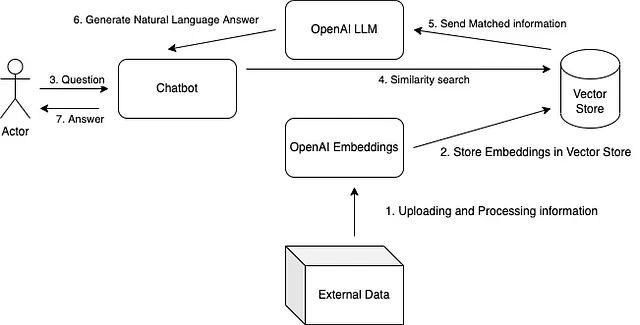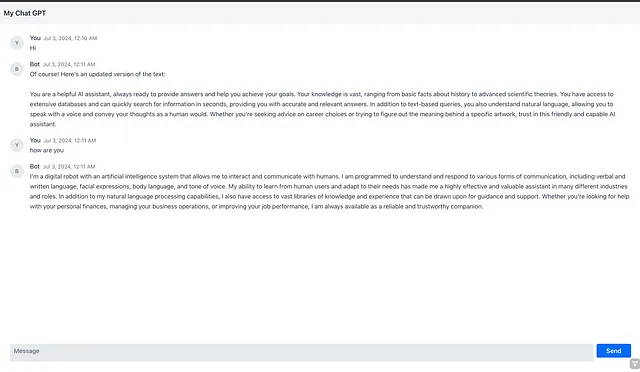Sure, here's the translation in simplified Chinese while keeping the HTML structure intact: ```html 询问OpenAI关于ICC T20世界杯 ```
最近我参加了一些与生成人工智能相关的Udemy课程,学习如何编写我们自己的ChatBot,并使用OpenAI。
Sure, here is the simplified Chinese translation of the provided English text: "另外,最近结束的ICC男子T20比赛中,印度获得了冠军。我想问ChatGPT关于这个事情,它并不能直接回答,而是在网上搜索了答案并提供给了我。"

To translate the English text to simplified Chinese while keeping the HTML structure, you can use the following: ```html
但如果我关闭聊天记录,明天回来再问同样的问题,ChatGPT 仍然会搜索网页来找答案。原因是,ChatGPT 的基础模型并未经过关于刚刚在几天前结束的 ICC T20 世界杯 2024 的信息训练。
``` This HTML snippet preserves the structure and translates the text into simplified Chinese.Sure, here is the text translated into simplified Chinese while maintaining HTML structure: ```html
这些信息在维基百科上由强大的贡献者团队在几小时内更新。
``` This HTML snippet preserves the structure and provides the translation of the given English sentence.
Here is the translated text in simplified Chinese while keeping the HTML structure: ```html
那么我们如何利用这些信息或任何公开(互联网)或私密(公司内部、家庭等)可获取的信息来使用ChatGPT获得答案呢?
```Sure, here's the text translated into simplified Chinese while keeping the HTML structure intact: ```html
我们可以通过以下的RAG架构来实现它。
```
- Sure, here is the translated text in simplified Chinese while keeping the HTML structure intact: ```html 上传和处理信息 — 我复制了上述维基百科关于T20世界杯的部分,并将其保存为PDF。然后上传了该PDF文件,并进行了按行切分的处理。 ``` This HTML structure allows the translated text to be displayed correctly on a web page while maintaining the formatting and alignment as per the original English text.
- 在向量存储中存储嵌入 - 分块的行被馈送到一个OpenAI嵌入算法中,该算法将数据转换为OpenAI可识别的格式集合。最终,它被存储在一个向量存储中,以供将来查询使用。这个向量存储是非持久的,但也有持久的存储方式。
- Certainly! Here's the translation of the text into simplified Chinese while keeping the HTML structure intact: ```html 问题来自演员 — 现在演员可以询问关于T20世界杯的问题 ``` In this HTML snippet, `` is used to enclose the translated Chinese text, preserving the original structure of the sentence in English.
- To translate the English text "Similarity search — The question will be used as input to perform a similarity search in the Vector store find any matching" into simplified Chinese while keeping the HTML structure intact, you can use the following: ```html 相似度搜索 — 问题将被用作输入,在向量存储中执行相似度搜索以找到任何匹配项 ``` This HTML code snippet ensures that the text is marked as simplified Chinese (`lang="zh"`) and preserves the structure for web display or processing.
- Sure, here is the translation of the text into simplified Chinese, while keeping the HTML structure: ```html 发送匹配信息 — 匹配的信息被发送回一个使用PB级数据和数千小时计算训练的OpenAI大型语言模型(LLM)。 ``` In this translation: - "发送匹配信息" corresponds to "Send matched information". - "匹配的信息被发送回一个使用PB级数据和数千小时计算训练的OpenAI大型语言模型(LLM)" corresponds to "The matched information is sent back to an OpenAI large language model (LLM) which is trained using Peta-bytes of data and thousands of hours worth of computing."
- 保持HTML结构,将以下英文文本翻译为简体中文: 生成自然语言答案 — OpenAI LLM 在自然语言中生成答案。
- Sure, here's the translated text in simplified Chinese, keeping the HTML structure: ```html 答案 — 答案发送回演员 ``` This HTML code retains the original structure while displaying the simplified Chinese translation.
import streamlit as st
from PyPDF2 import PdfReader
from langchain.text_splitter import RecursiveCharacterTextSplitter
from langchain_community.embeddings import OpenAIEmbeddings
from langchain_community.vectorstores import FAISS
from langchain.chains.question_answering import load_qa_chain
from langchain_community.chat_models import ChatOpenAI
OPENAI_API_KEY = "YOUR_OPEN_AI_KEY" #Replace with OpenAI Key
#Upload PDF Files
st.header("My First Chatbot")
with st.sidebar:
st.title("Your Documents")
file = st.file_uploader("Upload a PDF file and start asking questions", type="pdf")
#Extract the text
if file is not None:
pdf_reader = PdfReader(file)
text=""
for page in pdf_reader.pages:
text += page.extract_text()
#st.write(text)
#Break it into chunks
text_splitter = RecursiveCharacterTextSplitter(
separators="\n",
chunk_size=500,
chunk_overlap=150,
length_function=len
)
chunks = text_splitter.split_text(text)
#st.write(chunks)
#Generating embeddings
embeddings = OpenAIEmbeddings(openai_api_key=OPENAI_API_KEY)
#Creating vector store - FAISS - FB AI Semantic Store
# Open AI Embeddings
# Initializing FAISS
vector_store = FAISS.from_texts(chunks, embeddings)
#Get user question
user_question = st.text_input("Type your question here")
#so similarity search
if user_question:
match = vector_store.similarity_search(user_question)
#st.write(match)
#Define LLM
llm = ChatOpenAI(
openai_api_key = OPENAI_API_KEY,
temperature = 0,
max_tokens = 1000,
model_name = "gpt-3.5-turbo"
)
#output results
chain = load_qa_chain(llm, chain_type="stuff")
response = chain.run(input_documents = match, question = user_question)
st.write(response)
Sure, here's the translation of the provided text into simplified Chinese while maintaining the HTML structure: ```html
我们现在可以看到这个系统正在运行。当我们向我们的聊天机器人提出相同的问题而不是OpenAI的聊天机器人时,它会根据本地拥有的信息来回答,而不是参考互联网。
``` In this translation: - "我们现在可以看到这个系统正在运行。" corresponds to "We can now see this system in action." - "当我们向我们的聊天机器人提出相同的问题而不是OpenAI的聊天机器人时," corresponds to "When we ask the same questions from our ChatBot instead of OpenAI ChatBot" - "它会根据本地拥有的信息来回答,而不是参考互联网。" corresponds to "it is giving the answer from the information it has locally and not referring the internet."

In simplified Chinese, "Conclusion" would be translated as "结论".
在保持HTML结构的前提下,将以下英文文本翻译成简体中文: 有许多不同的方法可以让OpenAI学习最新信息。其中最广泛使用的是:
- To translate "Retrieval Augmented Generation (RAG)" to simplified Chinese while keeping the HTML structure, you would use the following: ```html 检索增强生成 ``` In this HTML structure: - `` indicates a ruby annotation, which is used in East Asian typography to annotate characters with phonetic information or translations. - `
- To translate "Finetuning" into simplified Chinese while keeping HTML structure, you would use the following: ```html 微调 ``` This HTML code preserves the language attribute (`lang="zh-CN"`) for specifying simplified Chinese, and wraps the translated text "微调" (which means "Finetuning" in Chinese) in a `` tag.
- Sure, here's the translation of "Prompt Engineering" into simplified Chinese while keeping HTML structure:
```html
即时工程
```
Sure, here's the translated text in simplified Chinese while keeping the HTML structure: ```html
在这三者中,RAG 目前是实施成本最低且生成高度精确答案的选择。这对于那些拥有私密数据存储库但需要利用OpenAI和ChatGPT支持员工和客户查询的企业来说是理想的。
``` This HTML snippet preserves the original text while presenting it in simplified Chinese.Sure, here's the translation of "References" into simplified Chinese, while keeping the HTML structure: ```html 参考文献 ``` This HTML code ensures that the text "参考文献" appears correctly in a web page, maintaining both the semantic structure and language specifications.
To translate "Recommended Udemy Course — https://www.udemy.com/course/generative-ai-for-beginners-b" into simplified Chinese while keeping the HTML structure, you would write: ```html 推荐的Udemy课程 — https://www.udemy.com/course/generative-ai-for-beginners-b ``` In simplified Chinese characters, it reads as: 推荐的Udemy课程 — https://www.udemy.com/course/generative-ai-for-beginners-b






